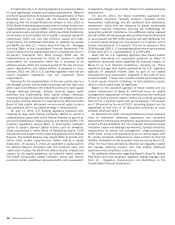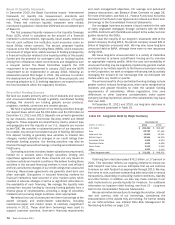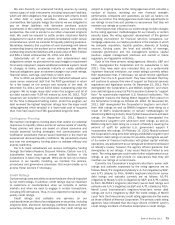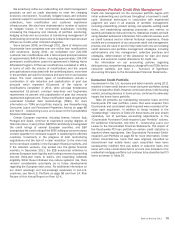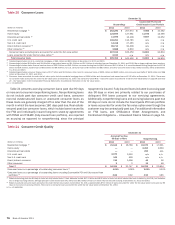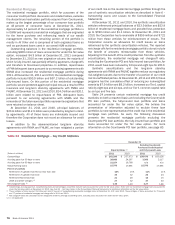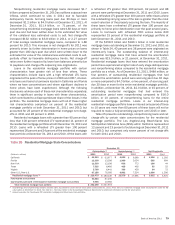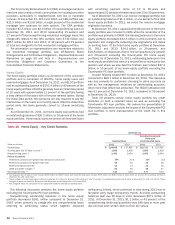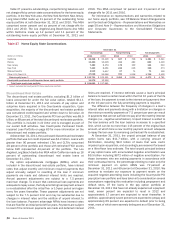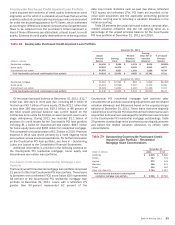Bank of America 2011 Annual Report Download - page 77
Download and view the complete annual report
Please find page 77 of the 2011 Bank of America annual report below. You can navigate through the pages in the report by either clicking on the pages listed below, or by using the keyword search tool below to find specific information within the annual report.Bank of America 2011 75
We proactively refine our underwriting and credit management
practices as well as credit standards to meet the changing
economic environment. To actively mitigate losses and enhance
customer support in our consumer businesses, we have expanded
collections, loan modification and customer assistance
infrastructures. We also have implemented a number of actions
to mitigate losses in the commercial businesses including
increasing the frequency and intensity of portfolio monitoring,
hedging activity and our practice of transferring management of
deteriorating commercial exposures to independent special asset
officers as credits enter criticized categories.
Since January 2008, and through 2011, Bank of America and
Countrywide have completed over one million loan modifications
with customers. During 2011, we completed over 225,000
customer loan modifications with a total unpaid principal balance
of approximately $49.9 billion, including approximately 104,000
permanent modifications under the government’s Making Home
Affordable Program. Of the loan modifications completed in 2011,
in terms of both the volume of modifications and the unpaid
principal balance associated with the underlying loans, most were
in the portfolio serviced for investors and were not on our balance
sheet. The most common types of modifications include a
combination of rate reduction and capitalization of past due
amounts which represent 60 percent of the volume of
modifications completed in 2011, while principal forbearance
represented 19 percent, principal reductions and forgiveness
represented six percent and capitalization of past due amounts
represented eight percent. These modification types are generally
considered troubled debt restructurings (TDRs). For more
information on TDRs and portfolio impacts, see Nonperforming
Consumer Loans and Foreclosed Properties Activity on page 86
and Note 6 – Outstanding Loans and Leases to the Consolidated
Financial Statements.
Certain European countries, including Greece, Ireland, Italy,
Portugal and Spain, continue to experience varying degrees of
financial stress. In early 2012, S&P, Fitch and Moody’s downgraded
the credit ratings of several European countries, and S&P
downgraded the credit rating of the EFSF, adding to concerns about
investor appetite for continued support in stabilizing the affected
countries. Uncertainty in the progress of debt restructuring
negotiations and the lack of a clear resolution to the crisis has
led to continued volatility in the European financial markets, and
if the situation worsens, may spread into the global financial
markets. In December 2011, the ECB announced initiatives to
address European bank liquidity and funding concerns by providing
low-cost three-year loans to banks, and expanding collateral
eligibility. While these initiatives may reduce systemic risk, there
remains considerable uncertainty as to future developments
regarding the European debt crisis. For additional information on
our direct sovereign and non-sovereign exposures in non-U.S.
countries, see Non-U.S. Portfolio on page 98 and Item 1A. Risk
Factors of this Annual Report on Form 10-K.
Consumer Portfolio Credit Risk Management
Credit risk management for the consumer portfolio begins with
initial underwriting and continues throughout a borrower’s credit
cycle. Statistical techniques in conjunction with experiential
judgment are used in all aspects of portfolio management
including underwriting, product pricing, risk appetite, setting credit
limits, and establishing operating processes and metrics to
quantify and balance risks and returns. Statistical models are built
using detailed behavioral information from external sources such
as credit bureaus and/or internal historical experience. These
models are a component of our consumer credit risk management
process and are used in part to help make both new and existing
credit decisions and portfolio management strategies, including
authorizations and line management, collection practices and
strategies, determination of the allowance for loan and lease
losses, and economic capital allocations for credit risk.
For information on our accounting policies regarding
delinquencies, nonperforming status, charge-offs and TDRs for the
consumer portfolio, see Note 1 – Summary of Significant
Accounting Principles to the Consolidated Financial Statements.
Consumer Credit Portfolio
Improvement in the U.S. economy and labor markets during 2011
resulted in lower credit losses in most consumer portfolios during
2011 compared to 2010. However, continued stress in the housing
market, including declines in home prices, continued to adversely
impact the home loans portfolio.
Table 20 presents our outstanding consumer loans and the
Countrywide PCI loan portfolio. Loans that were acquired from
Countrywide and considered credit-impaired were recorded at fair
value upon acquisition. In addition to being included in the
“Outstandings” columns in Table 20, these loans are also shown
separately, net of purchase accounting adjustments, in the
“Countrywide Purchased Credit-impaired Loan Portfolio” column.
For additional information, see Note 6 – Outstanding Loans and
Leases to the Consolidated Financial Statements. The impact of
the Countrywide PCI loan portfolio on certain credit statistics is
reported where appropriate. See Countrywide Purchased Credit-
impaired Loan Portfolio on page 83 for more information. Under
certain circumstances, loans that were originally classified as
discontinued real estate loans upon acquisition have been
subsequently modified from pay option or subprime loans into
loans with more conventional terms and are now included in the
residential mortgage portfolio, but continue to be classified as PCI
loans as shown in Table 20.





